Photo of the Day
 Saturday, October 18, 2008 at 11:37PM
Saturday, October 18, 2008 at 11:37PM 
Maasai Warrior Dance, Tanzania, September 2006
Canon 1DsMkII, 35mm f/1.4 L, 1/8000 @ f/2.0, ISO 100
I am an avid adventurer, conservationist, teacher, and outdoor photographer whose photography celebrates the African landscape and its rich wildlife, people, and culture. My photographic safaris allow my travelers to not only enhance their understanding of photography, lighting, and wildlife, but to develop a life-long admiration for Africa ‘s beauty and culture.
Banana Republic recently used my photographs as the cornerstone of their Urban Safari campaign, and my images were seen in all 750 stores around the globe, as well as in their billboards, catalogs and annual report. I was also the winner of the BBC Wildlife Photographer of the Year in the ‘Wild Places’ category in 2008 and a highly commended in the ‘Creative Visions of Nature’ category in 2007.
I launched Gura Gear in 2008, in an attempt to deliver lightweight camera bags to the market. I was looking for a lightweight camera bag to hold all of my photographic gear, and there was nothing desirable on the market that suited my needs. After spending 2 years with many prototypes, the Gura Gear Kiboko bag was born. More products are now available on the Gura Gear web site.
 Saturday, October 18, 2008 at 11:37PM
Saturday, October 18, 2008 at 11:37PM 
Maasai Warrior Dance, Tanzania, September 2006
Canon 1DsMkII, 35mm f/1.4 L, 1/8000 @ f/2.0, ISO 100
 Friday, October 17, 2008 at 09:34AM
Friday, October 17, 2008 at 09:34AM 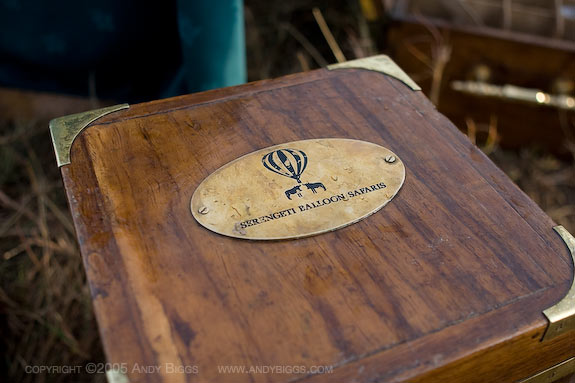
Serengeti Balloon Safaris champagne flute box
Serenget National Park, Tanzania. July 2005
 Wednesday, October 15, 2008 at 10:21PM
Wednesday, October 15, 2008 at 10:21PM Here is a quick link to an interview that I did recently:
 Tuesday, October 14, 2008 at 03:15PM
Tuesday, October 14, 2008 at 03:15PM "Dear Andy,
Mary and I had a great trip to Namibia with many unique and fun experiences. We thought our first trip to Africa with you was outstanding but this one was even better. Perhaps most memorable event among many was the confrontation between the white rhinos and pride of lions at the watering hole! You and your team of knowledgeable guides ensured that we were in the right places at the right times to observe the scenery and wildlife and take some wonderful photographs. You are a warm and gracious host who is genuinely interested in his guests and you consistently went above and beyond expectations to make sure that everyone was relaxed and enjoying themselves. Although your trips are designed for photographers, even the non-photographers in the group had a great time. Andy, you are a true professional and we are looking forward to our next trip with you!"
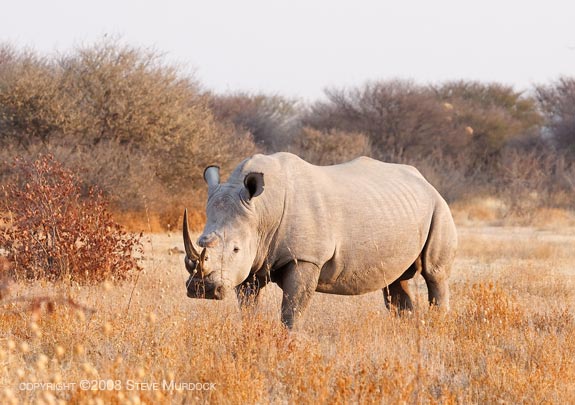
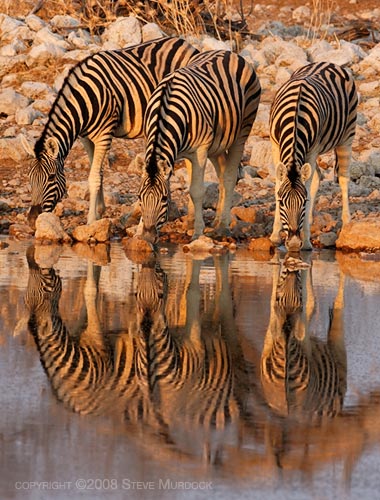
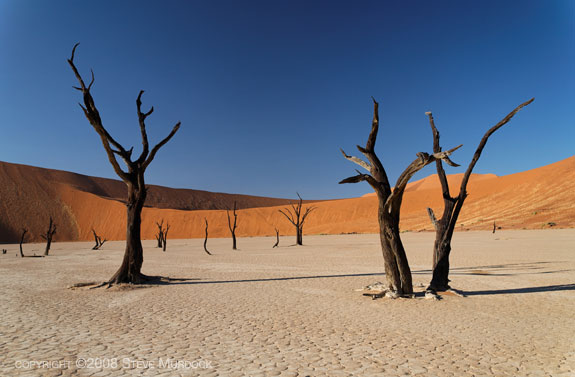

 Safaris,
Safaris,  Testimonials
Testimonials  Monday, October 13, 2008 at 04:17PM
Monday, October 13, 2008 at 04:17PM 
Acacias, Sunset and Dust, Ndutu, Ngorongoro Conservation Area, Tanzania. February 2005
Canon 1DMkII, 24-70mm f/2.8 L, 1/640 @ f/9, ISO 160
 Monday, October 13, 2008 at 02:01PM
Monday, October 13, 2008 at 02:01PM 
Flight over the Namib Desert, Namibia. September 2008
Canon 1DsMkIII, 24-105mm
 Sunday, October 12, 2008 at 02:01PM
Sunday, October 12, 2008 at 02:01PM There are many different types of safaris in Africa, and one should understand the differences between them. Here are some basic ideas of what the different types of safaris are, and what you might expect if you are to join one of these trips.
Photographic Safari
This is probably the most obvious and most requested of the safaris in Africa, although what is actually delivered can vary widely. Simply put, the photographic safari is a safari where photography is the primary purpose of the trip. Sometimes a photographic safari is really just a wildlife viewing safari and nothing else, and sometimes the safari can be a trip where all travelers are photographers with tons of equipment and photography is the only concern. And sometimes it is something in between. Some photographic safaris are safaris that have been put together for a group of people, possibly up to 12 people (like my own safaris), some safaris have a heavy teaching component to them, and some are nothing more than a safari that has been put together by a group of friends that are also keen photographers.
When I think of a photographic safari I think of like-minded people on safari that have photography as their main goal for the trip. I know that my photographic safaris are this way, with the added benefit of having leader of the group that is a photographer than also enjoys teaching photographic skills in a relaxed setting.
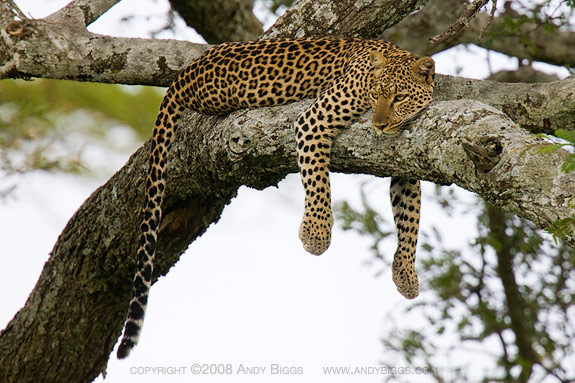
Leopard, Serengeti National Park, Tanzania. January 2008
Canon 1DsMkIII, 400mm f/4 DO IS + 2x TC, 1/250 @ f/8, ISO 1600
Walking Safari
Walking safaris are a great option for those travelers who are seeking a different view, as well as some exercise. Walking safaris can be extremely rewarding, as one is able to see and feel things that you cannot see from a vehicle. I have been on some amazing walking safaris where we were able to track white rhinos; something that is a much different experience when attempting from a vehicle. Many walking safaris focus on the smaller items, such as bugs, birds, trees, shrubs and tracking. A typical walking safari will take place in locations where there are fewer predators.
Cultural Safari
A cultural safari is one where the goal will be to interact with local communities. I have seen a trend in the industry to offer extensions to photographic safaris where there is a 'day of service' at the end of the trip. These days of service are opportunities to give back to communities in need, whether it is building schools, teaching a language, holding orphaned babies or just playing with children. Other types of cultural safaris might center around visiting villages for photographic opportunities. The ancient cultures of Ethipoia, the Maasai of Kenya and Tanzania, the Himba of Namibia come to mind.
Honeymoon Safari
Honeymoon safaris are typically private safaris, where the honeymooning couple arrange for a private vehicle and guide, and is setup as a custom itinerary.
Private Safari
A private safari might be one where you setup a custom itinerary, as opposed to selecting from a list of departure dates for itineraries that are shared with other people in a group. A private safari is one where the safari vehicle(s) is/are setup for the sole use of the travelers. Photographers often opt for such a safari, as photographers enjoy having more room in a vehicle for their camera gear. These photography trips could also be classified as group safaris, depending on the number of people on the trip.
Group Safaris
It is common in the safari industry for travel companies to publish a list of departure dates, and might allow for a maximum of 8 to 12 to 20 people in the group. The benefit is typically a cost savings.
Self Drive Safaris
There are some countries and parks that are excellent locations to do a self-drive safari. Countries such as Namibia, Botswana and South Africa are, in my opinion, the best self-drive locations.
Luxury Safari
This is a fairly obvious safari category!
Overland Safari
Overland safaris are setup as long journeys across multiple countries, often traveling over a month or longer period. The mode of travel is a large 4 wheel drive truck, and can accommodate up to 25 passengers. All travelers pitch their own tents, and often participate in the cooking and cleaning up of meals. This type of safari is attractive to college age travelers, and is quite affordable if you are willing to rough it for a little while.
Safari Extensions
Even if you book one of the safari types above, you can always add an extension to try something different. Here are some popular safari extensions:
In summary, there are many different types of safaris offered, and you should choose the type that best fits your needs. Since I am a photographer, I am mostly interested in visiting locations that have the best photography, but I am also interested in visiting locations that have the best vehicles for photographers, flexible dining schedules (we are out early and come back late), excellent guides and abundant wildlife.
 Sunday, October 12, 2008 at 09:19AM
Sunday, October 12, 2008 at 09:19AM If you are interested in creating better photographic prints, I am now offering private full-day mentoring sessions at my printing studio. This is an opportunity for you and I to work side by side to create beautiful prints from your own digital files. We can work on whatever you wish to work on, from digital capture to Lightroom workflow to digital output. The world is your oyster, and I am here to assist. Typical items that are usually covered:
These sessions are very informal, and are designed around getting information to you that is relative to your goals.
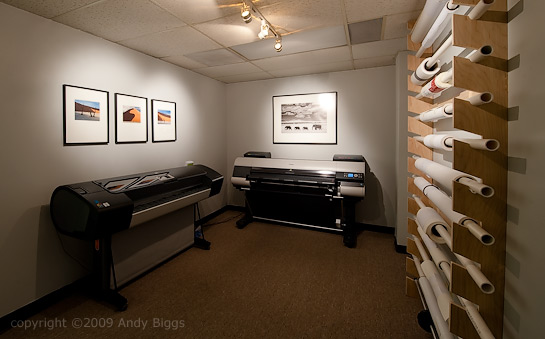
My location and equipment
Here is the equipment that I have in my studio in Houston, Texas (Memorial area, west of downtown):
The Cost
The cost of this all day (10 hours) session is $950, and will include the use of all printing materials, matting materials and perhaps the use of my assistant’s time if he is around to help out. A typical day will begin at 8am, and will end around 6pm. I have found it best to have a casual lunch break away from the studio to break the long day up. Oh, and lunch is on me. I also have an espresso maker in the office for those who need caffeine at all hours of the day.
The Signup process
All you need to do is to send me an email at andybiggs@gmail.com, and we can take it from there. My schedule is busy with Gura Gear and my photographic safaris, but we can carve out some time that works for both of us.
